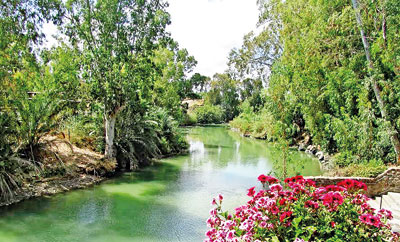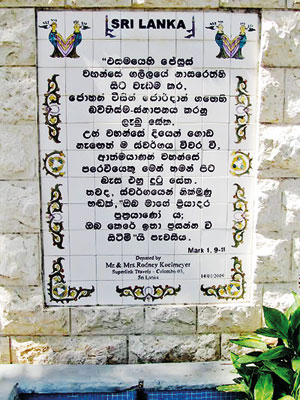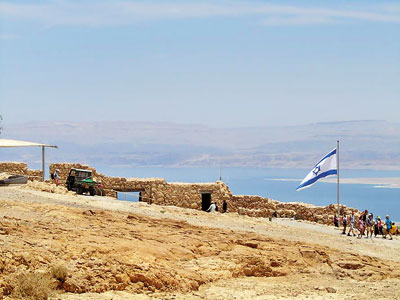From the river Jordan to the Dead Sea

The river Jordan--the Yardennit baptismal site
This is Israel – the “Holy Land’ considered sacred by Christians, Jews and Muslims, yet a land from which peace and goodwill seem so far removed.
This is the land where Jesus Christ lived and preached, the ”Promised Land” (Ha’Aretz HaMuvtahat) which Jews believe God gave to their patriarch Abraham and his descendants- and a land with a 17% Muslim population wherein lies Islam’s third holiest city.
Having spent the weekend exploring the city of Jerusalem, I decided to spend the next few days going further afield. Following the Six Day War of 1967, Israel captured the land on the west bank of the Jordan river from the Kingdom of Jordan – and Israel’s borders now extend from the Mediterranean coast on the west to the Jordan river on the east. At the south end of the river is the saltiest lake in the world, the Dead Sea, situated 423 metres below sea level (the earth’s lowest elevation on land). Towards the northern end of the river is the Sea of Galilee (actually a large freshwater lake) along the shores of which much of Jesus Christ’s ministry took place. Many of Jesus’ miracles – the feeding of the 5,000, calming the storm, walking on the water -were all supposed to have taken place here.

Panel in Sinhala at Yardennit
From Jerusalem, it takes about two hours to travel to Yardennit, one of the traditional sites along the Jordan River where Christian pilgrims come to be baptised just as Jesus himself was baptised in this river at a place called Qasr-el Yahud.While visiting Yardennit I was impressed by the Wall of New Life which consisted of about 40 panels of beautifully hand-painted Armenian tiles. Each panel carries the Bible verse describing the baptism of Jesus in a different language, from the tribal tongues of West Africa to the Roman script of modern European languages to the unique scripts of Asia. I was very pleased to see here the panel donated by a Sri Lankan couple carrying the verse in Sinhalese script!
The area where Jesus spent most of his short life was on the western shores of the Jordan River and the Sea of Galilee – places like Nazareth where he spent his boyhood, Tabgha (where the feeding of five thousand people took place), the Mount of the Beatitudes (where Jesus delivered the Sermon on the Mount, probably his best known discourse) and Caphernaum (which has the ruins of an ancient fourth century synagogue).
It was peaceful walking along the shore – and even stepping into the water – of the Sea of Galilee – and in particular absorbing the view of the sea from the Mount, where now stands the beautiful Church of the Beatitudes.
Having seen the lowest freshwater lake in the world in Galilee, I set off the following day to see the world’s lowest salt water lake, the Dead Sea at the southern end of the Jordan River. The water here is about ten times as salty as the ocean – the salt concentration being so high that one cannot sink in this water. One can peacefully float in the water and look across at the mountains of Jordan on the opposite shore (as I did) and apply the therapeutic black mud from the sea bed on one’s body (which I did not!). The high salinity precludes any plants and animals from living in these waters – hence the name Dead Sea.

The summit of Masada overlooking the Dead Sea and the hills of Jordan
The mineral content of the water, the therapeutic reputation of Dead Sea mud and the low content of pollens and other allergens in the region have made this an important centre for health research.
On my trip to the Dead Sea, I was keen to visit the famous UNESCO Wold Heritage site of Masada –the isolated plateau of rock upon which the Jewish King Herod the Great built a fortified palace during the first century BCE. I could not help drawing comparison to King Kasyapa’s fifth century palace atop Sigiriya.
The archaeological ruins of Masada were fascinating – but what is more significant about this place is the story of the Siege of Masada.
During the Great Jewish Revolt against the Romans that began in the year 66 CE, a group of Jewish rebels, the Sicarii, fled to King Herod’s former palace atop Masada and took refuge there. Over time more Jewish refugees and rebels arrived until Masada was harbouring some 900 Jews who had fled the Romans –at which time the Roman governor decided to lay siege to the place. The rebels held out for almost three years, but in April 73 the Romans, having built a siege ramp, finally succeeded in breaching the walls and entering the citadel. When they entered, however, they made a horrifying discovery: the Jewish rebels trapped and with nowhere to escape to from the top of the citadel had, rather than be captured by the Romans, all killed themselves – preferring a “glorious death to a life of infamy and slavery”.
Masada has become a symbol of sacrifice and resistance for modern Israel – strengthening the people’s resolve that there shall never be another Masada, that Jewish people will never be subjugated again.
Masada is a haunting place – made all the more poignant because of its associated history and legends.
For more information, check https://new.goisrael.com/area/galilee
For an aerial video view of Masada, seehttps://vimeo.com/134929132


